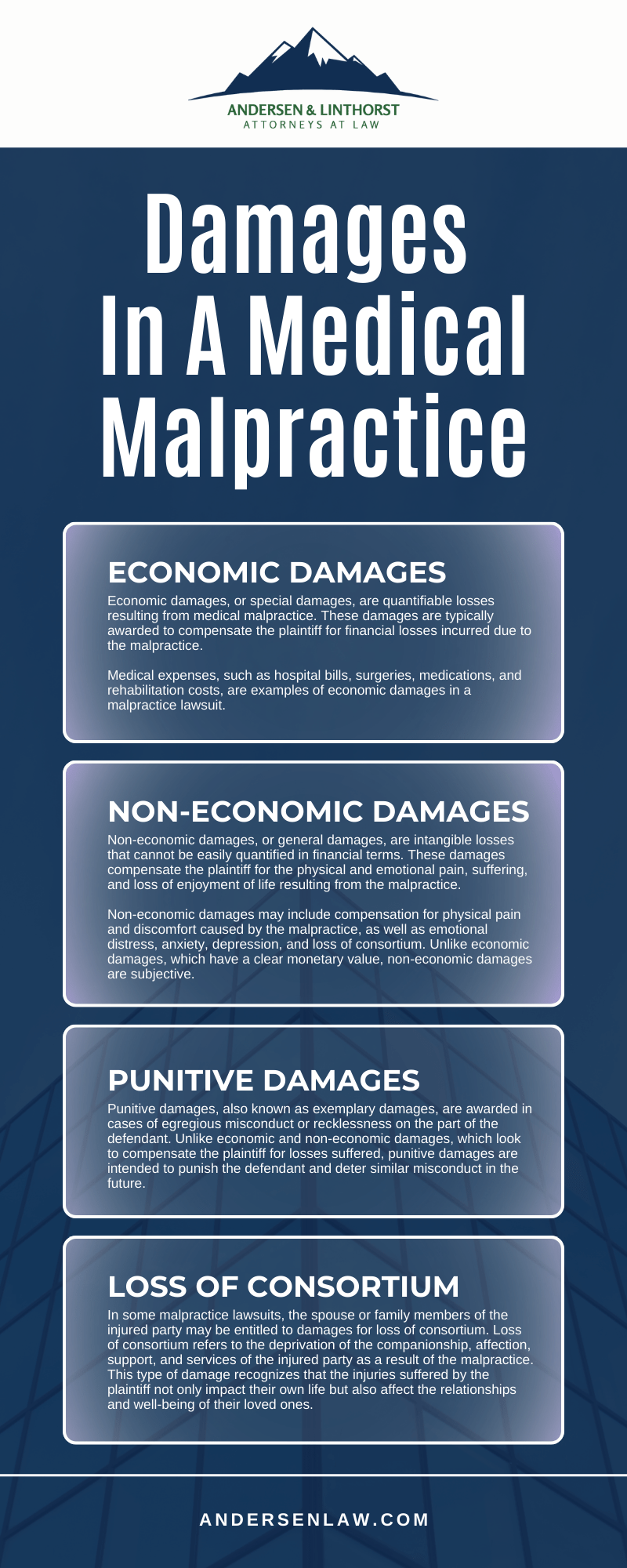
Doctors and other medical professionals often provide heroic work that saves the lives of people. They frequently offer medical care with a sense of integrity and quality. However, there are times when a doctor may fall short and cause a patient’s health to worsen or life to be taken away. A medical error or oversight can result in serious injury or fatality for a patient. This is why everyone is encouraged to also be their own doctor, listen to their body, and if something doesn’t seem right getting a second opinion from another doctor may be a wise choice. Our Klamath Falls, OR medical malpractice lawyer has helped many people just like you, who want to know if their situation warrants filing a lawsuit. Please contact our team at Andersen & Linthorst as soon as possible for a consultation.
An Overview Of Medical Malpractice
Medical malpractice happens when a doctor or other health professional fails to offer sufficient care or abide by practice standards. A medical provider who does something that leads to injury or death of a patient may be charged with medical malpractice. A doctor may be charged if they provide poor care to the patient. Injured patients may sue the doctor and/or healthcare facility for the suffering caused. As our Klamath Falls medical malpractice attorney can review, examples of medical malpractice can include, but are not limited to, the following:
- Absence of Informed Consent: failure to inform and obtain consent from a patient about potential risks associated with treatment, surgery, etc.
- Persistent Symptoms: worsening condition due to the doctor’s failure to provide proper care or from having committed negligence or an oversight.
- Delayed Diagnosis: failure of a doctor to give the patient a timely diagnosis.
- Unusual After Surgery Symptoms: bruising, bleeding, and swelling after surgery may not be normal and could have been the cause of a procedure that was not done correctly or safely.
- Doctor Dismisses Concerns or Questions: every doctor should listen to their patient’s concerns and answer questions fully so that the patient is fully aware of their health, diagnosis, and provided other relevant information.
- Incorrect Diagnosis: when a doctor fails to correctly diagnose a patient due to misinterpreting symptoms, misreading lab or diagnostic tests, etc.
- Understaffed Medical Facility: Hospitals and other medical facilities may be understaffed, which can result in lower-quality care and mistakes.
Andersen & Linthorst
There are many ways that a doctor may commit an oversight, mistake, or negligence. If you suspect that your doctor made a crucial error, then now is the time to consult with our Oregon medical malpractice attorney about a potential case. Our team at Andersen & Linthorst can come to your aid immediately. We understand that realizing your doctor made a mistake in regards to your care can be a scary thought. You can trust us to advocate for your fair compensation in the matter. First, let us consult with you to learn more and then advise what the next step would be. Please contact us today.
What Is An Example Of Negligence In The Medical Field?
While often unintentional, a Klamath Falls, Oregon medical malpractice lawyer knows that medical negligence can have serious and sometimes fatal consequences for patients. One illustrative example of medical negligence involves misdiagnosis or delayed diagnosis. In this scenario, a healthcare provider fails to accurately identify a patient’s medical condition promptly, leading to prolonged suffering, complications, or even death. If you have been harmed due to medical negligence, call Andersen & Linthorst to find out how our firm can help.
What Is Medical Negligence?
Consider the case of a patient presenting to the emergency room with symptoms suggestive of a heart attack, such as chest pain, shortness of breath, and nausea. Despite the urgency of the situation, the attending physician fails to order the appropriate diagnostic tests, such as an electrocardiogram (ECG) or blood tests, to confirm or rule out a myocardial infarction. Instead, the patient is sent home with a diagnosis of indigestion and advised to take over-the-counter antacids.
Days later, the patient’s condition deteriorates further, prompting them to seek medical attention once again. This time, a different physician orders the necessary tests and discovers that the patient did indeed suffer a heart attack. However, the delay in diagnosis has allowed the condition to worsen, resulting in irreversible damage to the heart muscle and a poorer prognosis for the patient.
In this scenario, the healthcare provider’s failure to diagnose the patient’s condition constitutes a clear case of negligence promptly and accurately. By neglecting to follow established diagnostic protocols and failing to recognize the severity of the patient’s symptoms, the physician compromised the patient’s health and violated their duty of care.
Medication Errors
Another example of medical negligence involves medication errors, which occur when healthcare providers administer the wrong medication, dosage, or medication to which the patient is allergic. These errors can have serious consequences, ranging from adverse drug reactions and complications to life-threatening emergencies.
For instance, imagine a nurse administering a high dose of medication to a patient without carefully checking the patient’s medical history or verifying the correct dosage. Unaware of the patient’s allergies or underlying health conditions, the nurse administers the medication as prescribed, only to discover later that the patient has experienced a severe allergic reaction requiring immediate intervention.
In this case, the nurse’s failure to adhere to proper medication administration protocols constitutes a breach of the standard of care, resulting in harm to the patient. While the error may have been unintentional, it nevertheless represents a serious lapse in judgment and diligence on the part of the healthcare provider.
Surgical Errors
Negligence in the medical field can also manifest in surgical errors, such as wrong-site surgery, retained surgical instruments, or anesthesia-related complications. These mistakes can have devastating consequences for patients, leading to unnecessary pain, disability, or even death.
Consider the case of a patient undergoing surgery to remove a benign tumor from their abdomen. Due to a communication breakdown between members of the surgical team, the surgeon operates on the wrong side of the patient’s body, removing healthy tissue instead of the tumor. As a result, the patient must undergo additional surgery to correct the error, prolonging their recovery time and increasing the risk of complications.
In this scenario, the surgical team’s failure to adhere to established safety protocols and verify the correct surgical site constitutes a clear case of negligence. Despite the complexity and high stakes of surgical procedures, such errors are entirely preventable with proper communication, teamwork, and attention to detail.
Have You Been A Victim?
If you believe you have suffered injuries from medical negligence, call Andersen & Linthorst to schedule a confidential consultation and find out what legal recourse you may have. Each Klamath Falls medical malpractice lawyer from our firm has extensive experience in malpractice law are committed to diligently advocating for their clients.
Damages Available In A Medical Malpractice Lawsuit
If you have suffered harm because of a medical professional’s negligence, a Klamath Falls, OR medical malpractice lawyer can evaluate your case and determine what type of financial compensation (damages) you may be entitled to. The following is an overview of what type of damages may be awarded. It is important to keep in mind, however, that every case is different. To find out what type of case you may have, call Andersen & Linthorst directly.
Economic Damages
Economic damages, or special damages, are quantifiable losses resulting from medical malpractice. These damages are typically awarded to compensate the plaintiff for financial losses incurred due to the malpractice.
Medical expenses, such as hospital bills, surgeries, medications, and rehabilitation costs, are examples of economic damages in a malpractice lawsuit.
Economic damages may also encompass lost wages or income due to the plaintiff’s inability to work due to the malpractice. The purpose of these damages is to reimburse the plaintiff for their financial hardships due to the healthcare provider’s negligence.
Non-Economic Damages
Non-economic damages, or general damages, are intangible losses that cannot be easily quantified in financial terms. These damages compensate the plaintiff for the physical and emotional pain, suffering, and loss of enjoyment of life resulting from the malpractice.
Non-economic damages may include compensation for physical pain and discomfort caused by the malpractice, as well as emotional distress, anxiety, depression, and loss of consortium. Unlike economic damages, which have a clear monetary value, non-economic damages are subjective. They may vary depending on the injuries’ severity and impact on the plaintiff’s quality of life. Your Klamath Falls medical malpractice lawyer can determine what type of non-economic damages you may qualify for.
Punitive Damages
Punitive damages, also known as exemplary damages, are awarded in cases of egregious misconduct or recklessness on the part of the defendant. Unlike economic and non-economic damages, which look to compensate the plaintiff for losses suffered, punitive damages are intended to punish the defendant and deter similar misconduct in the future.
Punitive damages may be awarded when the defendant’s actions are deemed willful, wanton, or malicious and when compensatory damages alone are insufficient to adequately punish the defendant or deter others from engaging in similar behavior. However, punitive damages are not available in all malpractice cases and are typically reserved for cases involving particularly egregious conduct.
Loss Of Consortium
In some malpractice lawsuits, the spouse or family members of the injured party may be entitled to damages for loss of consortium. Loss of consortium refers to the deprivation of the companionship, affection, support, and services of the injured party as a result of the malpractice. This type of damage recognizes that the injuries suffered by the plaintiff not only impact their own life but also affect the relationships and well-being of their loved ones.
Spouses may be awarded compensation for the loss of intimacy and companionship, while family members may receive damages for the loss of parental guidance, support, and household services. Loss of consortium damages look to address the emotional and practical consequences of the malpractice on the plaintiff’s relationships and family life.
Call Our Personal Injury Law Firm For Legal Assistance
If you or a loved one has suffered injuries in what you believe to be a case of malpractice, it is critical to have a Klamath Falls medical malpractice lawyer evaluate your case and determine what type of damages you may qualify for. Call Andersen & Linthorst to schedule a free case evaluation and learn what your legal options may be.
Klamath Falls Medical Malpractice Infographic
Medical Malpractice FAQs
Navigating a medical malpractice case can be complex, requiring detailed knowledge of medical standards and legal procedures. Seeking guidance from a knowledgeable Klamath Falls medical malpractice lawyer is crucial to understanding your rights and options. The following are some of the most common questions our lawyers at Andersen & Linthorst hear from our clients.
What Constitutes Medical Malpractice?
Medical malpractice occurs when a healthcare provider fails to meet the standard of care expected in their profession, resulting in harm or injury to a patient. This can include:
- Negligence: Such as misdiagnosis, delayed diagnosis, surgical errors, or medication mistakes.
- Failure to inform: Not providing adequate information about risks and alternatives before treatment.
- Breach of duty: Not adhering to established protocols or guidelines.
- Informed consent violations: Performing a procedure without the patient’s informed consent or against their wishes.
To prove medical malpractice, one must demonstrate that the healthcare provider’s actions or lack thereof directly caused harm that wouldn’t have occurred otherwise.
How Do I Know If I Have A Valid Malpractice Case?
Determining the validity of a malpractice case involves several factors:
- Injury or harm: There must be clear evidence that the patient suffered harm due to the healthcare provider’s actions.
- Standard of care: It must be established that the provider deviated from the accepted medical standard of care.
- Causation: There needs to be a direct link between the provider’s actions and the harm suffered by the patient.
- Damages: Evidence of damages such as medical bills, lost wages, or pain and suffering must be documented.
Consulting with a qualified Klamath Falls medical malpractice lawyer is crucial. They can assess the specifics of your case and determine whether legal action is appropriate.
What Is The Statute Of Limitations For Filing A Medical Malpractice Lawsuit?
The statute of limitations refers to the time limit within which a lawsuit must be filed after the incident or discovery of harm and varies by state. In Oregon, the statute of limitations for malpractice is two years. Key points to note:
- Discovery rule: Some states allow the clock to start ticking from the date the malpractice was discovered rather than when it occurred.
- Minors: The statute of limitations may be extended for cases involving minors, often starting from the date they turn 18.
Missing the statute of limitations deadline typically results in the inability to file a lawsuit, so it’s essential to consult with an attorney promptly if you suspect malpractice.
What Compensation Can You Pursue In A Medical Malpractice Case?
Compensation sought in a malpractice case, also known as damages, can include:
- Medical expenses: Costs related to additional treatment, surgeries, medications, or rehabilitation.
- Lost wages: Income lost due to the injury or recovery period.
- Pain and suffering: Physical pain, emotional distress, and loss of enjoyment of life.
- Punitive damages: In extreme negligence or misconduct cases, punitive damages may be awarded to punish the defendant.
The amount of compensation varies widely based on the severity of the harm and the specifics of the case. An experienced attorney can help estimate potential damages and negotiate on your behalf.
Call Our Personal Injury Law Firm For Legal Assistance
If you suspect you are a victim of medical malpractice, contact Andersen & Linthorst to schedule a free and confidential consultation with a dedicated Klamath Falls medical malpractice lawyer and take the steps to get financial justice for the harms you have suffered.
Meet Our Team
Andersen & Linthorst Attorneys At Law
Personal Injury Lawyers in Oregon
Experienced. Focused. Service.
We are here because we have a passion for correcting injustice and helping injured people be treated fairly after the losses they have suffered. Insurance companies take advantage of people in almost every case, and we are here to help.
We’re with you every step of the way, from the moment we accept your case until it’s finally resolved. Your case may be settled through “informal negotiations,” “mediation,” “arbitration,” or possibly even a “jury trial“. Regardless of which process is used, you will always be the one to decide whether to accept or reject an offer to settle. We’ll help you understand your options at each point of decision, so that you can decide what is right for you. If the insurance company agrees to pay a fair amount, an out-of-court settlement is the best option. But if the insurance company won’t deal fairly, we are fully able and willing to take your case to court.raphy
You may contact us at any time. If you are not yet a client, we provide a free first interview with absolutely no obligation. In this free interview we will let you know your legal rights, how we can help you, and whether or not you need an attorney. This is part of our service to the community – helping people know whether they have a case and whether they need an attorney.
Personal Injury Blog
Andersen & Linthorst Attorneys At Law
-
How Slip And Fall Accidents Can Lead To Long-Term Brain And Spinal Injuries
Most people associate a slip and fall with temporary soreness, bruises, or perhaps a broken bone. However, medical research shows that falls are one of the leading causes of serious,...
Read blog -
Lasting Impact Of A Slip And Fall Injury
Slip and fall accidents are among the most common causes of serious injury in the United States. What often begins as a simple fall can result in long-term physical and...
Read blog -
When Medical Malpractice Leads To Death
Filing A Claim When Medical Malpractice Leads To Death Losing a loved one due to medical malpractice is one of the most devastating experiences a family can face. When a...
Read blog



